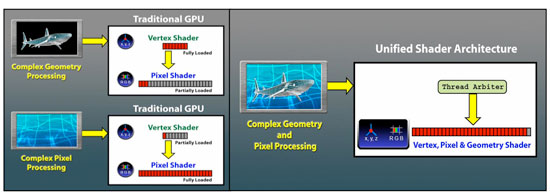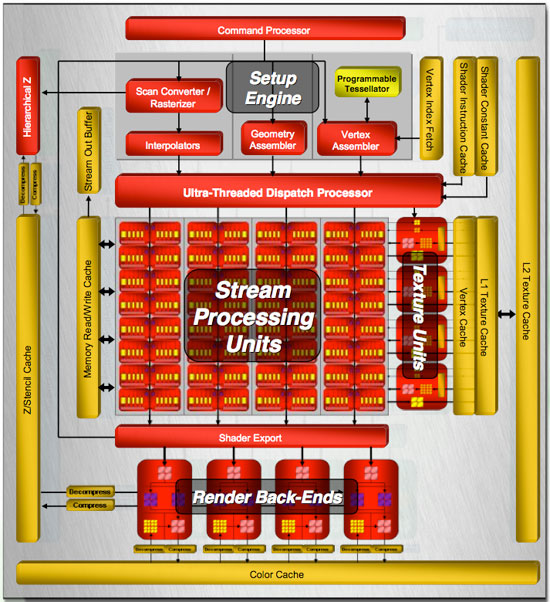ATI Radeon HD 2900 XT: Calling a Spade a Spade
by Derek Wilson on May 14, 2007 12:04 PM EST- Posted in
- GPUs
R600 Overview
From a very high level, we have the same capabilities we saw in the G80, where each step in the pipeline runs on the same hardware. There are a lot of similarities when stepping way back, as the same goals need to be accomplished: data comes into the GPU, gets setup for processing, shader code runs on the data, and the result either heads back up for another pass through the shaders or moves on to be rendered out to the framebuffer.

The obvious points are that R600 is a unified architecture that supports DX10. The set of requirements for DX10 are very firm this time around, so we won't see any variations in feature support on a basic level. AMD and NVIDIA are free to go beyond the DX10 spec, but these features might not be exposed through the Microsoft API without a little tweaking. AMD includes one such feature, a tessellator unit, which we'll talk about more later. For now, let's take a look at the overall layout of R600.

Our first look shows a huge amount of stream processing power: 320 SPs all told. These are a little different than NVIDIA's SPs, and over the next few pages we'll talk about why. Rather than a small number of SPs spread across eight groups, our block diagram shows R600 has a high number of SPs in each of four groups. Each of these four groups is connected to its own texture unit, while they share a connection to shader export hardware and a local read/write cache.
All of this is built on an 80nm TSMC process and uses in the neighborhood of 720 Million transistors. All other R6xx parts will be built on a 65nm processes with many fewer transistors, making them much smaller and more power efficient. Core clock speed is on the order of 740MHz for R600 with memory running at 825MHz.
Memory is slower this time around with higher bandwidth, as R600 implements a 512-bit memory bus. While we're speaking about memory, AMD has revised their Ring Bus architecture for this round, which we'll delve into later. Unfortunately we won't be able to really compare it to NVIDIA's implementation, as they won't go into any detail with us on internal memory buses.
And speaking of things NVIDIA won't go into detail on, AMD was good enough to share very low level details, including information on cache sizes and shader hardware implementation. We will be very happy to spend time talking about this, and hopefully AMD will inspire NVIDIA to start opening up a little more and going deeper into their underlying architecture.
To hit the other hot points, R600 does have some rather interesting unique features to back it up. Aside from including a tessellation unit, they have also included an audio processor on their hardware. This will accept audio streams and send them out over their DVI port through a special converter to integrate audio with a video stream over HDMI. This is unique, as current HDMI converters only work with video. AMD also included a programmable AA resolve feature that allows their driver team to create new ways of filtering subsample data.
R600 also features an independent DMA engine that can handle moving and managing all memory to and from the GPU, whether it's over the PCIe bus or local memory channels. This combined with huge amounts of memory bandwidth should really assist applications that require large amounts of data. With DX10 supporting up to 8k x 8k textures, we are very interested in seeing these limits pushed in future games.
That's enough of a general description to whet your appetite: let's dig down under the surface and find out what makes this thing tick.










86 Comments
View All Comments
johnsonx - Monday, May 14, 2007 - link
and to which are you going to admit to?What was that old saying about glass houses and throwing stones? Shouldn't throw them in one? Definitely shouldn't them if you ARE one!
Puddleglum - Monday, May 14, 2007 - link
You mean, while it does compete performance-wise?johnsonx - Monday, May 14, 2007 - link
No, I'm pretty sure they mean DOESN'T. That is, the card can't compete with a GTX, yet still uses more power.INTC - Monday, May 14, 2007 - link
Chadder007 - Monday, May 14, 2007 - link
When will we have the 2600's out in review?? Thats the card im waiting for.TA152H - Monday, May 14, 2007 - link
Derek,I like the fact you weren't mincing your words, except for a little on the last page, but I'll give you a perspective of why it might be a little better than some people will think.
There are some of us, and I am one, that will never buy NVIDIA. I bought one, had nothing but trouble with it, and have been buying ATI for 20 years. ATI has been around for so long, there is brand loyalty, and as long as they come out with something that is competent, we'll consider it against their other products without respect to NVIDIA. I'd rather give up the performance to work with something I'm a lot more comfortable with.
The power though is damning, I agree with you 100% on this. Any idea if these beasts are being made by AMD now, or still whoever ATI contracted out? AMD is typically really poor in their first iteration of a product on a process technology, but tend to improve quite a bit in succeeding ones. I wonder how much they'll push this product initially. It might be they just get it out to have it out, and the next one will be what is really a worthwhile product. That only makes sense, of course, if AMD is now manufacturing this product. I hope they are, they surely don't need to make anymore of their processors that aren't selling well.
One last thing I noticed is the 2400 Pro had no fan! It had a heatsink from Hell, but that will still make this a really attractive product for a growing market segment. Any chance of you guys doing a review on the best fanless cards?
DerekWilson - Wednesday, May 16, 2007 - link
TSMC is manufacturing the R600 GPUs, not AMD.AnnonymousCoward - Tuesday, May 15, 2007 - link
"I bought one, had nothing but trouble with it, and have been buying ATI for 20 years."That made me laugh. If one bad experience was all it took to stop you from using a computer component, you'd be left with a PS/2 keyboard at best.
"...to work with something I'm a lot more comfortable with."
Are you more comfortable having 4:3 resolutions stretched on a widescreen? Maybe you're also more comfortable with having crappier performance than nvidia has offered for the last 6 months and counting? This kind of brand loyalty is silly.
MadBoris - Monday, May 14, 2007 - link
As far as your brand loyalty, ATI doesn't exist anymore. Furthermore AMD executives will got the staff so you can't call it the same.Secondly, Nvidia has been a stellar company providing stellar products. Everyone has some ups and downs. Unfortunately with the hardware and drivers this is ATI's (er AMD's) downs.
This card should do ok in comparison to the GTS, especially as drivers mature. Some reviews show it doing better than GTS640 in most tests, so I am not sure where or how discrepencies are coming about. Maybe hardware compatibility, maybe settings.
rADo2 - Monday, May 14, 2007 - link
Many NVIDIA 8600GT/GTS cards do not have a fan, are available on the market now, and are (probably; different league) much more powerful than 2400 ;) But as you are a fanboy, you are not interested, right?